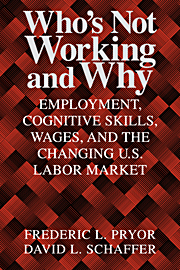Book contents
- Frontmatter
- Contents
- List of tables and charts
- Acknowledgments
- Introduction
- Employment, Cognitive Skills, and Job Displacement
- Wage Levels and Distribution
- 5 Wage Levels
- 6 The Distribution of Hourly Wages
- Alternative Approaches
- Implications and Interpretations
- Appendix Notes
- Bibliography
- Name Index
- Subject Index
6 - The Distribution of Hourly Wages
Published online by Cambridge University Press: 25 March 2010
- Frontmatter
- Contents
- List of tables and charts
- Acknowledgments
- Introduction
- Employment, Cognitive Skills, and Job Displacement
- Wage Levels and Distribution
- 5 Wage Levels
- 6 The Distribution of Hourly Wages
- Alternative Approaches
- Implications and Interpretations
- Appendix Notes
- Bibliography
- Name Index
- Subject Index
Summary
In the previous chapter we focus on a series of issues relating to the average level of wages in various subgroups of the labor force. A key finding is that over the last quarter-century, a growing excess supply has occurred throughout much of the U.S. labor market and that a growing excess demand has appeared primarily in the market for university graduates with relatively high cognitive skills.
In that discussion we touch on several issues involving the wage distribution and show three important trends underlying the growing gap in average wages between those with and without a university degree. (1) The growing wage gap is driven primarily by the substantial reduction in wages for those with less than a university degree, rather than an increase in wages of those with a university degree. (2) The real wages for the university-educated increased only because a minority of workers – those in the upper one-third of the wage distribution – experienced considerable increases in real wages over this period. (3) Some of what others are interpreting as an increased rate of return to education is in fact an increased rate of return to cognitive skills independent of education.
We now turn our attention more directly to the distribution of wages of workers both within and across occupations. A large amount of previous research by economists has convinced most observers that wage inequality has increased significantly over the last quarter-century, not just for the U.S. population as a whole but also within most subgroups of the population. However, most of these results are based on just one or two summary measures of the wage distribution as a whole.
Information
- Type
- Chapter
- Information
- Who's Not Working and WhyEmployment, Cognitive Skills, Wages, and the Changing U.S. Labor Market, pp. 137 - 169Publisher: Cambridge University PressPrint publication year: 1999
